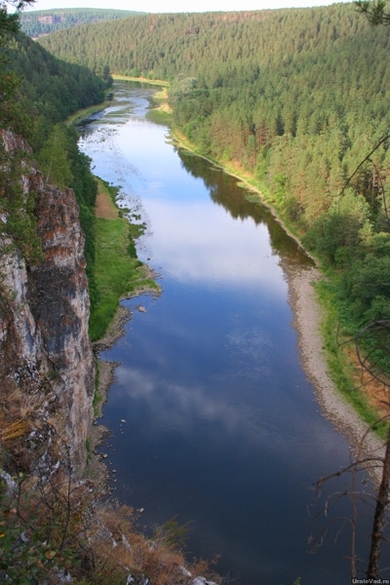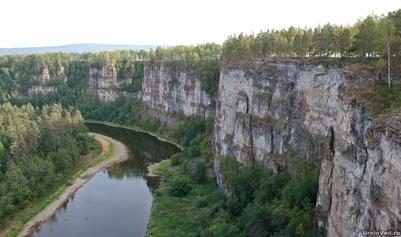Big Ducks
One of the most famous and popular attractions of the South Ural River Ai is the Rock of Great Prises. This is a high and long rock wall, up to 100 meters high.
The Ay River, of course, is one of the most beautiful rivers in the Urals. Translated from Bashkir, its name means “Moon” or “Moon River”. It flows through the territory of the Chelyabinsk region and Bashkiria. The river is 549 kilometers long. There are many picturesque rocks, many caves.

Big Ducks is the visiting card of the Ay River. They impress with their scale and beauty.
The definition of "Large" conveys the size of the rocks. "Cliffs" in relation to the rocks is very common in these places (in contrast, for example, from Chusova, where the rocks are called stones). Rocks here are called cliffs vertically breaking off to the river. The word comes from “cramp”, “cliff”.
But the Tatars and Bashkirs call these rocks differently - Sybar Kaya, which means "motley rock". And indeed it is. What only shades does the rocky wall of the Great Ducks not have, including thanks to lichens.
The rock, almost a kilometer long, curved in an arc along the left bank of the river, making a right turn here.
The Big Ducks are completely sheer. Only in one place (and not without difficulty) can one go up.
There are several caves in the Great Princes (Grotto Youth, First and Second Backstage, etc.).
Only climbers can visit the Youthful Grotto, descending a rope from above on a completely vertical rock wall. The height of the grotto from the foot of the cliff is 56 meters, and from the top to the entrance to the cave 26 meters.
Previously, local residents from the village of Kulmetovo called the darkening rock, the impregnable cave of Karatash or Karakuashi (Black Stone, Black Hole). The modern name arose in 1969, when the cave was first examined by pupils of the club of young geologists from the city of Korkino under the guidance of the caver S.M. Baranova. The following 1970, they surveyed the cave.
The mainsail has a two-by-three-meter rectangular inlet, oriented southeast. Shortly after the entrance, a well four meters deep is formed. From the four-meter-long grotto at the bottom of the well, a narrow gap leaves leading to the rest of the cave. In cold weather and until the beginning of summer, this part of the cave is covered with beautiful ice formations. The last hall for a reason is called the Ice Saber Hall. Ice stalactites hanging from above are similar in shape to sabers, their length reaches 12 meters.
Another move is from the entrance to the cave inland. It is narrow, 30 meters long. In total, the total length of the cave is 90.5 meters, the depth is 21 meters (in the hall of Ice Sabers).
Today, a cross is set up on a rock near the Youthful Grotto by someone.
To the right of the Youthful Grotto, clearly visible from the water, you can climb to the top of the Great Drags by the crevice (couloir). Rafting along the Ay River, do not miss this opportunity. Planks are laid here with the bars pinned across. This makes it easier to climb, but there are stones near the boards that roll down and can injure below walking people. Be careful!

Shortly before the end of the ascent to the mountain, there are two small caves - the First and Second Lobsters, so named for their location on the lobby. Their length is 23 and 44 meters. For the first time they were investigated by the Satka cavers of the club "Search" in July 1978 under the direction of V.V. Roshchin.
From the top of the Great Drags, a beautiful view of the rocks and the surrounding area, onto the Ai River valley opens. Cliffs are visible above and below the river. From here, the ships sailing along the river seem very tiny. There is an equipped observation deck at the Great Princes. Behind the trees is a large field where grazing horses can be seen. Here is the Alekseevskaya livestock farm. On the field there are karst funnels. In the southeast, beyond the field, the mountains turn blue - the Kukshik Range.
Climbers train at Great Drags, and extreme people jump from them.
